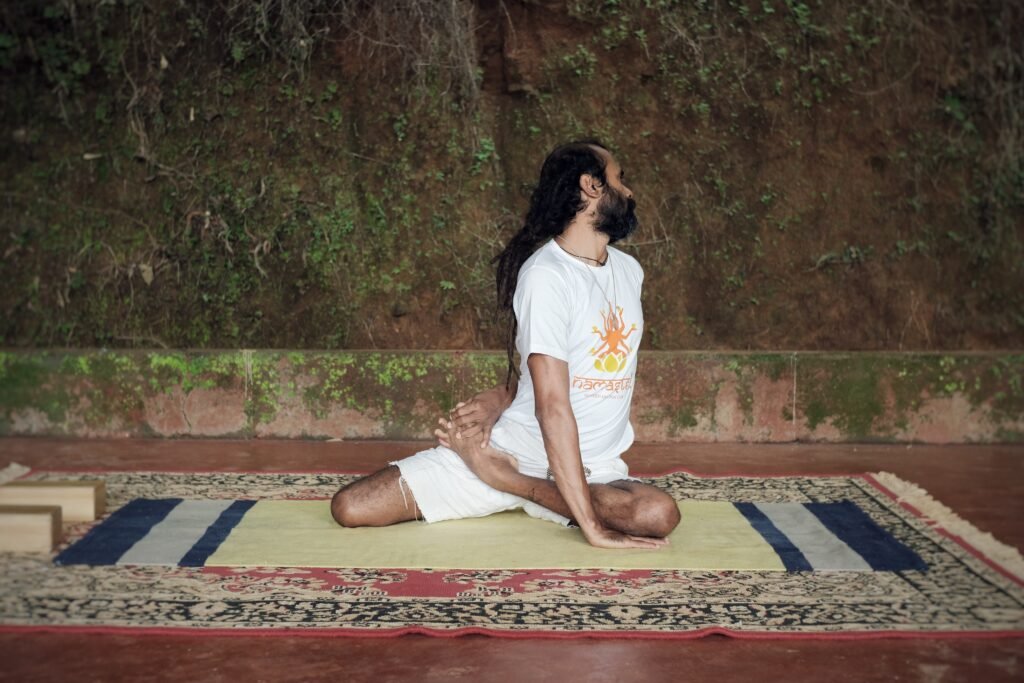
Bloating is one issue that gets worse as you get older. We completely comprehend the struggle of those severely affected by this digestive disorder, even though mild bloating is not particularly painful. One of the most annoying symptoms of bloating is a swollen body, but other common symptoms include gas, constipation, and pain in the abdomen.
These days, it is a widespread issue that can result from digestive issues, heavy meals, or stress. Most of us experience tightness and fullness in the stomach, leading to pain and discomfort in the lower abdomen.
Yoga can help manage this uncomfortable condition, and there are many over-the-counter medications and treatments to eliminate bloating.
Regular yoga practice can improve digestion by increasing blood flow to the digestive system and reducing bloating, gas, and other gut-related issues.
Particularly twisting yoga poses to aid in massaging and compressing the internal organs, allowing gas to pass through the digestive system and easing any tight or pressurized feelings in the stomach.
Does yoga help with bloating?
Yoga can ease stomach bloating, and it has even been shown in studies to ease menstrual cramps.
Yoga reduces bloating primarily through two mechanisms: physical stimulation of the digestive system and stress reduction, that improves digestion.
Physical Relief:
Some yoga poses focus on the digestive system and abdominal organs to relieve a bloated stomach. Stretching, gentle twisting, massaging, and stimulating the digestive organs to help these asanas move things along.
Stress Relief:
Deep breathing exercises and relaxation also help to relieve stress by calming the nervous system and enabling access to the parasympathetic (or “rest and digest”) state.
What results in stomach bloating and gas pain?
You could feel gassy for several reasons.
However, the following are the top two reasons for gas pain and bloating in the stomach:
Swallowing air:
Gas enters your digestive system when you swallow air.
Everybody inhales air when they eat, drink, or laugh.
Some people, however, breathe in more air than others.
Chewing gum or eating or drinking too quickly can both cause this.
When you emit, the majority of extra air exits the digestive system.
Consuming food that is difficult to digest:
The small intestine has difficulty digesting some ingredients, such as sugar, starch, and fiber.
They move in the large intestine, where bacteria break down the undigested carbohydrates.
This results in gas, which can cause flatulence. The procedure is organic.
Between 13 and 21 times a day is typical for gas passages. Beans, lentils, and vegetables like broccoli and cabbage are some foods that cause gas. Carbonated beverages like soda or beer can also exacerbate your digestive tract’s gas production.
Yoga Pose Twist, Fold Forward and Lengthen the Lower Abdomen to Reduce Bloating
The next time you feel bloated after a large meal, hold off on taking any medications.
Try yoga as a quick, natural way to relieve stress and ease bloating.
The best poses are the asanas that engage your abs, fold your body forward, twist your core, and extend your stomach upward.
To avoid feeling too heavy later, enjoy the stretch, and don’t be afraid to let the gas out freely!
1. Pawanmuktasana
A powerful asana that can treat digestive issues is called Pawanmuktasana, also known as the wind-relieving pose. It can eliminate waste from the body by causing the bowels to move more quickly. This yoga pose helps to burn belly fat while also improving digestion, constipation, and indigestion.
Additionally, it helps to reduce lower back tension and strengthens the spinal cord and abdominal muscles. It eliminates fat from the waist, thighs, and abdomen. Additionally, it increases ovarian stimulation, which lowers infertility.
2. Malasana
The best yoga pose to treat constipation, one of the most frequent causes of gas and bloating, is Malasana, also known as Garland pose.
This yoga pose strengthens your digestive system by opening your hip muscles, stretching and contracting your abdomen, and strengthening your spine and buttocks. Try to hold the same position for the best results for a few seconds before relaxing.
3. Vajrasana
It is a kneeling yoga position that is most frequently connected to metabolism. Constipation is relieved and prevented by it, and the pelvic muscles can be strengthened by it, too. The diamond pose or pelvic pose are two names for it, and it aids in neutralizing acidity and flatulence.
It guarantees that the body will absorb nutrients more effectively.
Vajrasana is a beneficial exercise after eating because it aids digestion.
4. Supta Virasana
Numerous health benefits can be obtained from this yoga position, including relief from diarrhea, respiratory conditions, intestinal issues, and acidity. The reclining hero pose, or Supta Virasana, strengthens the legs’ extensor muscles and facilitates the release of stomach gas.
5. Ardha matsyendrasana
The upper body is energized, and this traditional twisting pose aids digestion. It provides a satisfying massage to your stomach, intestines, and kidneys. Doing so reduces indigestion and bloating-related pain and discomfort. It also stimulates the spine, which twists and pulls all the stiffness out of your back. Stretching the shoulders, hips, and neck relieves upper and middle back pain. It assists in improving your sitting posture and relieves stress from your stomach and internal organs.
6. Ustrasana
One of the best yoga poses on our list for increasing metabolism is ustrasana. Deep backward bending of the body is performed while kneeling in ustrasana. Its purpose is to stretch the hips and spine while opening up the entire front part of the body, hence the name “camel pose.” Additionally, it activates and stimulates the thyroid, which ultimately boosts metabolism.
These yoga postures have been advocated since dawn for their scientifically validated effects and advantages to increase metabolism, lessen acid reflux, relieve gas, and reduce bloating.
To reap the therapeutic benefits of yoga, practice all of these poses and other yogic exercises under the direction of a qualified yoga instructor.
Before beginning your practice, speak with a qualified yoga instructor or doctor, especially if you are expecting, have a medical condition, or are a beginner.
